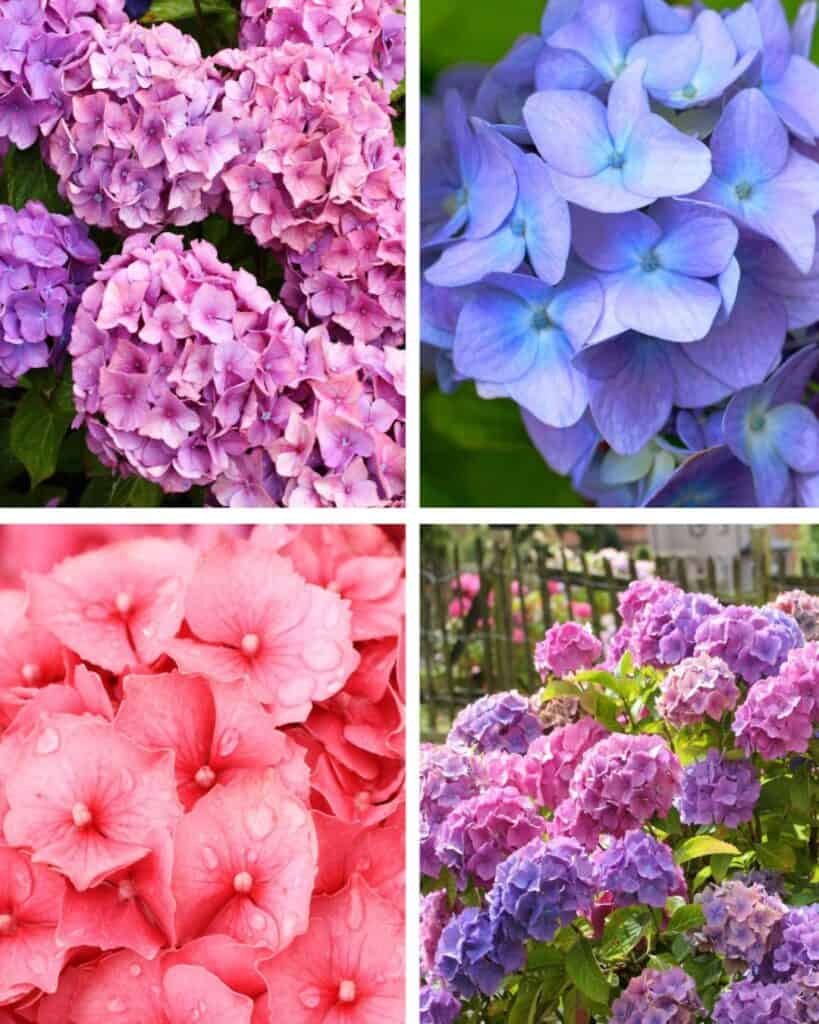Hydrangeas are known for their iconic, eye-candy blooms. However, they can sometimes be puzzling when they don’t bloom as expected. You’re not alone if you’ve ever found yourself with a hydrangea bush full of lush green leaves but no blooms.
Below are ten reasons why your hydrangeas might not bloom, along with solutions to fix each problem.
Why Aren’t My Hydrangeas Flowering?
If you’re a gardening enthusiast or just enjoy the sight of blooming hydrangeas in your backyard, it can be disappointing when these beautiful bushes fail to bloom.
Despite our best efforts, hydrangeas sometimes reluctantly hold back on producing their impressive color spectrum. This could be due to a variety of reasons.
The Many Faces of Hydrangea Bloom Problems
- Misguided Pruning: Pruning your hydrangeas at the wrong time can nip the flower buds in the bud (no pun intended), thwarting their blooming potential.
- Unsatisfactory Light Exposure: Inadequate sunlight or excessive exposure can pose significant roadblocks in blooming.
- Unfavorable Soil Conditions: Soil pH levels, nutrient deficiencies, and soil health can greatly influence hydrangea’s growth and blooming cycle.
- Inappropriate Watering Techniques: Overwatering or underwatering can hamper or significantly delay your hydrangeas’ bloom phase.
- Tough Winter Survivals: Harsh winters can wreak havoc on the plant, obliterating the chances of bloom in the following spring.
- Incidence of Disease or Pests: Common diseases or pests can pose a serious threat to hydrangeas’ blooming capacities.


Each of these factors is critical to the delicate blooming process. However, these common hydrangea bloom roadblocks can be deftly maneuvered with a little diligence and the right techniques.
The following sections provide more detailed insights on tackling each issue and helping your hydrangeas bloom to their fullest potential.
#1 – Incorrect Pruning
Hydrangeas showcase their vibrant blooms most impressively when properly pruned. However, if pruned at the incorrect time, it could negatively affect its blooming capability.
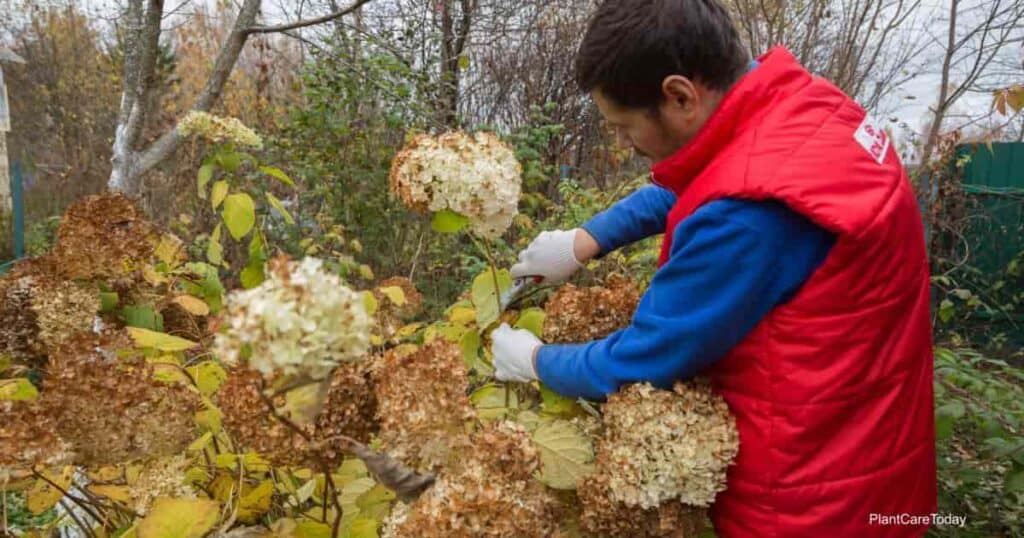

Pruning at the Wrong Time
Incorrectly timed pruning is a common reason why hydrangeas might not be blooming. Each species of hydrangea has its unique timeline for setting buds.
For instance, bigleaf hydrangeas, both mopheads and lacecaps, bloom on “old wood” – the term given to stems that have been on the hydrangea since the summer before the current season.
If you prune these species in late summer, autumn, or winter, you might inadvertently remove the buds set for next year’s flowers, leading to a lack of blooms.
The Right Time to Prune
To encourage your hydrangeas to bloom:
- For hydrangeas that bloom on old wood, prune these right after they’ve flowered, but no later than mid-July.
- For those that bloom on new wood (like the panicle and smooth hydrangeas), pruning in late winter or early spring provides ample time for the plant to produce new growth that will subsequently bloom.
Essential Tips for Pruning Hydrangeas
Understanding the nature of your particular hydrangea species is key to proper pruning. Below are some useful tips:
- Use sharp tools for cleaner cuts.
- Remove dead wood and old flowers, which promotes healthier growth.
- Remove one-third of the oldest branches at the base to rejuvenate the plant.
If you’re unsure, it is better to forgo pruning altogether since not pruning will not kill your hydrangea. Prioritize understanding the particular characteristics of your hydrangea species and its blooming patterns.
Incorrect pruning can lead to a disappointing hydrangea bloom, but with these tips, you are well on your way to ensuring your hydrangeas showcase their iconic blossoms every year.
#2 – The Role of Sunlight in Hydrangeas Growth
Like all plants, Hydrangeas rely heavily on sunlight for their growth and blooming processes. Consequently, inadequate sunlight can hinder the blooming process of your hydrangeas.
Sunlight triggers photosynthesis, a critical process through which plants convert light into chemical energy, which aids growth and flowering.
Sunlight Requirements for Hydrangeas
Though each hydrangea variant may need slightly different sunlight, a common guideline exists for most hydrangeas.
- Morning Sunlight: Full sun in the morning, with relatively cooler temperatures, is best for hydrangeas. The morning sun helps the plant produce the necessary energy for growth and flowering, preventing fungal diseases by drying the morning dew on the leaves.
- Afternoon Shade: Direct and intense sunlight in the afternoon can wilt hydrangeas. Dappled or full shade in the afternoon protects them from excessive heat.
It’s essential to adhere to these sunlight exposure guidelines to promote robust blooming in your hydrangeas. However, exceptions exist, and some hydrangea species may need more or less sunlight. Thus, researching your specific variant is crucial.
Insufficient sunlight might cause your hydrangeas to remain stuck in a cycle of lush greenery without blossoms. Understanding and adjusting your plant’s sunlight requirements can significantly increase the chance of your hydrangeas blooming as expected.
Ultimately, it’s all about providing the best conditions for your plants to flourish, guaranteeing a garden full of magnificent, blooming hydrangeas.
#3 – Too Much Sunlight
While sunlight is paramount for hydrangea blooms, it’s a myth that they love basking in the sun all day. It’s crucial to understand and maintain a balance with sun exposure.
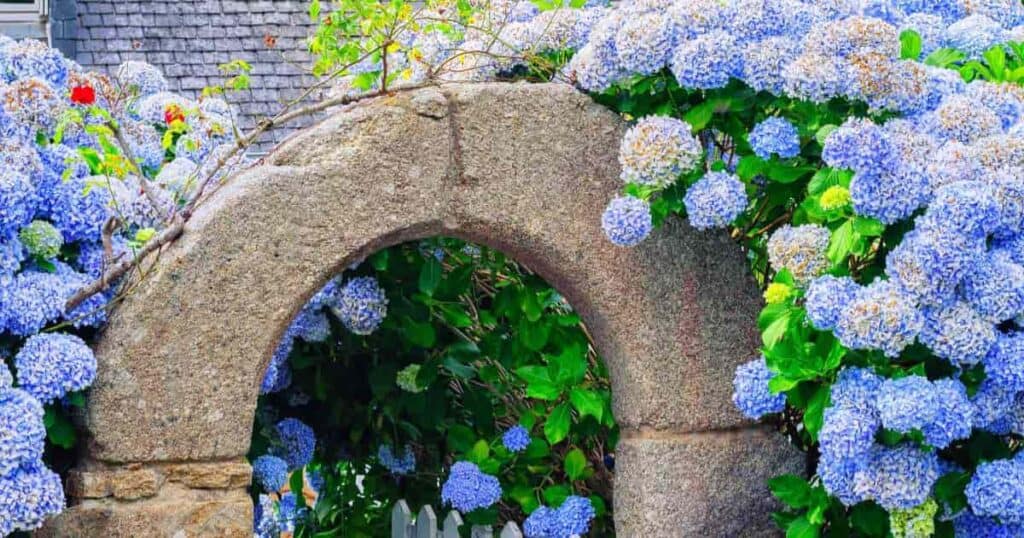

The Problem of Excessive Sun Exposure
Hydrangeas generally are lovers of the morning sun, but they still require a certain degree of shelter from the harsh afternoon rays. Overexposure to the sun can lead to dehydration, causing your hydrangeas to be wilted, scorched, or heat-stressed – all discouraging the blooming process.
You might also perceive that the overall color of your hydrangeas is fading; this could be the aftermath of excessive sunlight exposure.
The Sweet Spot of Sunlight
So, how much sun is just right? This can vary based on the exact variety of your hydrangea, but speaking broadly, hydrangeas do well with about four to six hours of sunlight each day.
Mostly, they prefer morning sunlight and filtered, dappled light in the afternoon. A spot that offers some afternoon shade might be the perfect location for your hydrangea bush.
Remember, too, that indirect light can be as beneficial as direct – it’s often better for keeping blossoms vibrant. Proactively monitoring and adjusting the amount of sunlight exposure, if needed, can sometimes be the one step to transform a leafy bush into a profusely blooming hydrangea.
Striking a Balance
Navigating the sunlight needs for hydrangeas might seem tricky. With time and careful observation, though, you’ll be able to strike the perfect balance between sun and shade for your hydrangeas.
As the adage goes, “moderation in all things” fits perfectly here. Keep the sunlight exposure balanced – not too little, not too much – and enjoy the stunning bursts of color that your hydrangeas will reward you with.
#4 – Soil pH is Inappropriate
Understanding and balancing soil pH is key to maintaining the health and bloom of your hydrangeas. Let’s delve into how inappropriate soil pH levels can affect these plants.
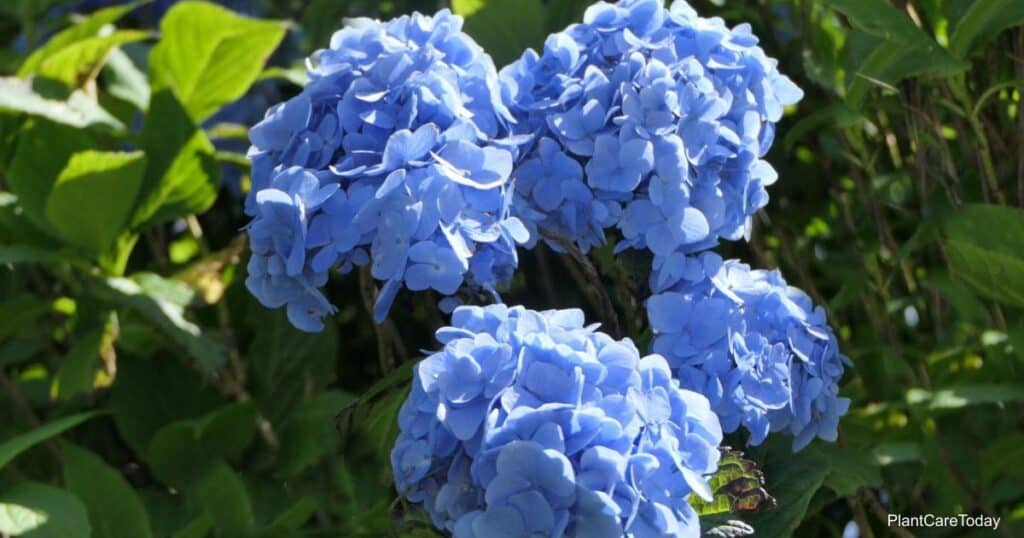

Why Soil pH Matters
Soil pH measures the acidity or alkalinity of soil, an aspect that greatly affects plant nutrient availability. Hydrangeas are peculiar as their bloom colors vary based on the pH level. However, if the pH is too extreme (either too alkaline or too acidic), your hydrangeas may struggle with blooming.
Wrong pH Levels and their Consequences
- Too Acidic (pH : Extremely acidic soil can hinder the availability of essential nutrients like phosphorus, which hydrangeas need for blooming. The acid condition might also cause aluminum toxicity.
- Too Alkaline (pH > 7.5): On the other hand, a highly alkaline environment could bring about calcium or magnesium toxicity. Hydrangeas may struggle to absorb iron and manganese, becoming less vibrant or not blooming at all.
Adjusting Soil pH Levels
Hydrangeas typically thrive in soil pH levels of 5.5 to 6.5. If you suspect your soil pH may be hindering your hydrangeas’ bloom, here’s how you can go about it:
- Perform a soil test: The first step is to confirm the pH levels. Use a soil test kit or seek help from a local county extension service.
- Correcting Acidic Soil: Incorporating garden lime can help raise the pH if your soil is too acidic. Follow product instructions for precise application rates.
- Correcting Alkaline Soil: If your soil is too alkaline, consider adding elemental sulfur, iron sulfate, or organic matter like compost, peat moss, or cottonseed meal to lower the pH. Again, use according to product instructions.
Remember, adjusting soil pH is not an instant process—it may take several months. Patience and regular monitoring are vital to achieving the balanced pH level that hydrangeas love.
Final Word on Hydrangea pH
Keeping soil pH in check ensures a bounty of beautiful blooms each year. Testing, monitoring, and altering pH as needed will help your hydrangeas thrive and shower you with enchanting flowers.
Remember, no plant care technique is a one-size-fits-all solution – individual plant needs can vary. Watch your plants and let them guide you to their specific needs.
Hydrangeas are thirsty plants, and watering issues often contribute to a lack of blooming. Developing correct watering habits is crucial for hydrangeas’ healthy growth and blooming.
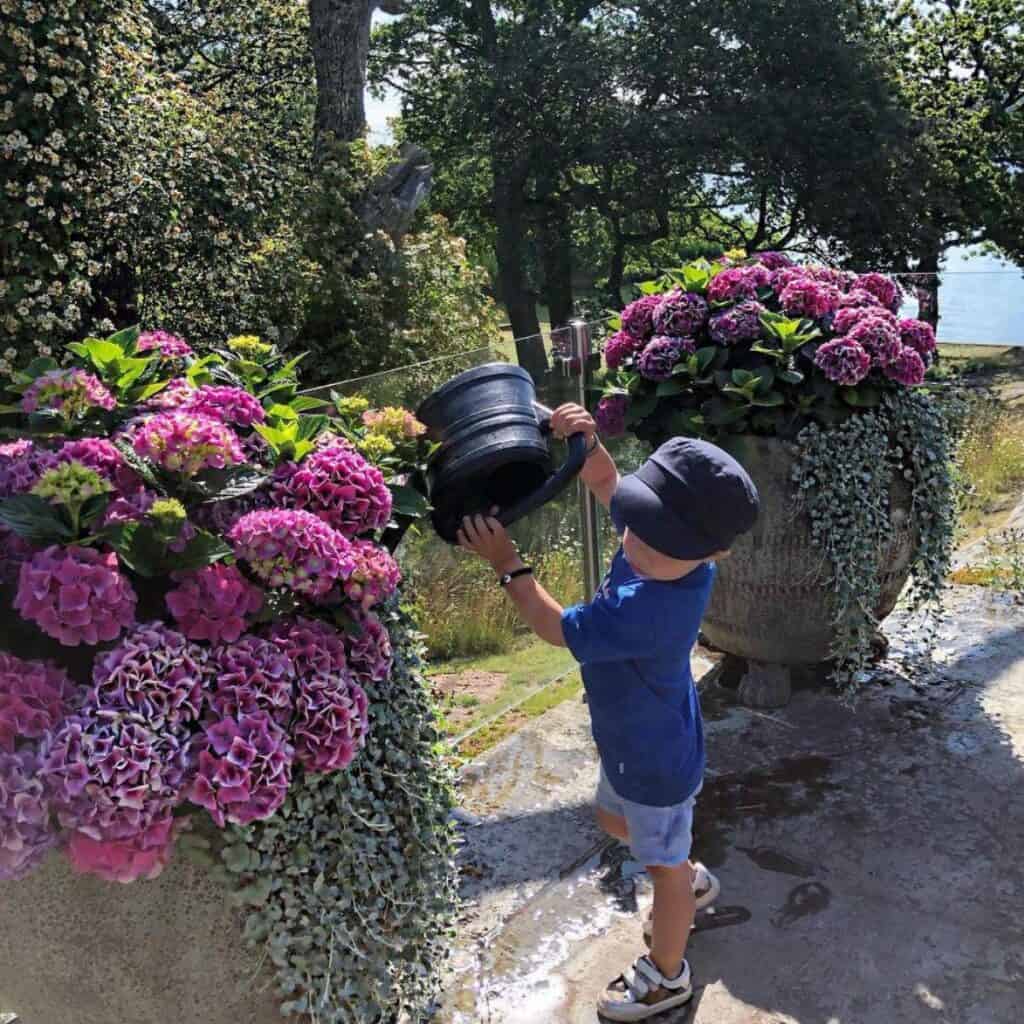

Identifying Watering Problems
- Under-watering: Hydrangeas that receive inadequate water can find it difficult to bloom. Water is essential for these plants to produce the energy they need to blossom.
- Over-watering: Conversely, excessive watering can cause harm, leading to root rot. This weakens the plant and can inhibit blooming.
Implementing Correct Watering Techniques
Adopting the right watering techniques can make a significant difference to your hydrangeas.
- Water Deeply: Aim to keep the soil moist but not soaking to ensure your hydrangea receives enough water. Deep watering every 2-3 days is usually better than daily light watering. The goal here is to saturate the roots, not just the surface.
- Optimal Watering Time: Try to water your hydrangea early in the morning or late in the evening when temperatures are lower, thus preventing water loss from evaporation.
- Monitoring Rainfall: If your region receives ample rainfall, you might not need to water your hydrangeas manually.
- Watching for Over-Watering Signs: If you notice yellowing leaves, this could indicate over-watering. In such cases, you should adjust your watering schedule and double-check that your plant isn’t left sitting in water, thus avoiding root rot.
Balancing Hydrangea Watering
Improper watering habits can severely impact hydrangea blooming. Understanding your hydrangeas’ unique hydration needs and adjusting your watering techniques can promote a more bountiful blooming season.
Remember, the key to thriving blooms isn’t just about providing enough water but ensuring there’s neither an excess nor a deficit.
#6 – Nutrient Deficiency
Even though Hydrangeas are not particularly picky about their nutrient requirements, lacking certain elements could hinder their blooming ability.
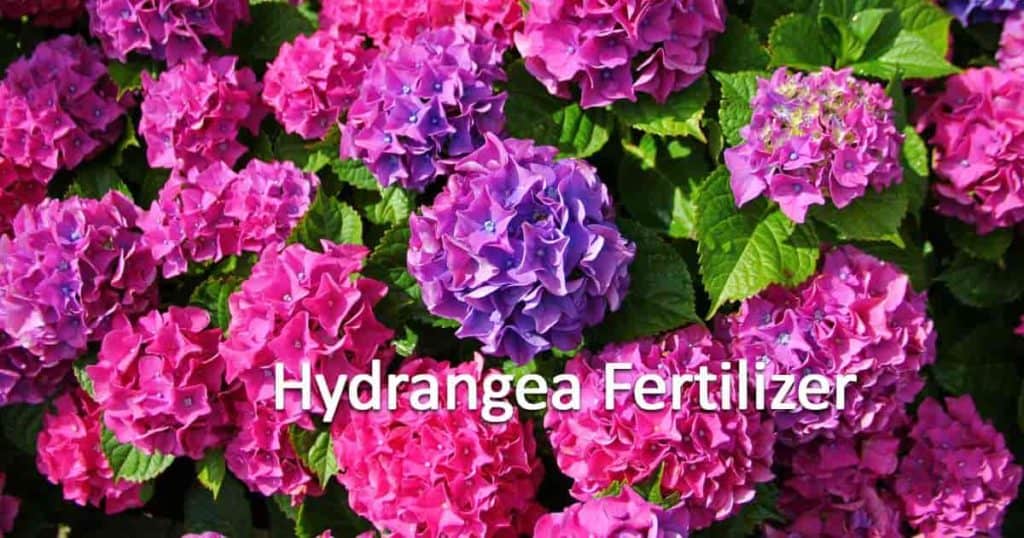

Vital Role of Nutrients
All plants need a balanced range of nutrients to thrive, and hydrangeas are no different. They primarily need nitrogen for healthier leaves, phosphorus for root development and bloom stimulation, and potassium for overall vigor.
Deficiency Signs
- Yellowing leaves: This points towards a potential nitrogen deficiency.
- Smaller, fewer blooms: This might be due to insufficient phosphorus.
- Weak stems and slow growth: Shortage of potassium often shows up as these symptoms.
Balanced Fertilization Is A Necessity
A nutrient imbalance can be rectified through the right fertilization. Use a slow-release, balanced fertilizer meant for flowering plants. A 10-10-10 NPK (Nitrogen-Phosphorus-Potassium) ratio is often suggested.
- Adding compost or well-rotted manure can provide an organic, long-term solution.
- Controlled, regular feeding using a water-soluble plant food can additionally boost nutrient levels.
Soil Testing
If your hydrangeas still refuse to bloom despite your best efforts, checking your soil’s nutrient content could provide insights. Soil testing kits are readily available online or at your local garden center.
- Collect soil samples from different parts of your garden for accurate results.
- Follow the instructions on the kit for precise readings.
- Adjust your fertilization regime based on the test results.
Nutrient deficiency could be a silent killer of your hydrangea’s blooms. Recognize the signs early and rectify them through balanced feeding and a thorough soil test if needed. A little nutrient boost could give your hydrangeas the push they need to burst into a spectacular bloom.
#7 – Harsh Winters and Hydrangeas
Harsh, cold winters can be extremely challenging for hydrangeas, leading to significant damage that may prevent blooming in spring. Let’s break down how winter impacts hydrangeas and the measures to counteract this.
The Impact of Frigid Winters
Hydrangeas are delicate plants that can be negatively affected by prolonged frosty conditions. Winter elements exact twofold pressure:
- Freezing Cold: Extended periods of extreme cold can freeze the buds, preventing them from blooming in spring.
- Heavy Snowfall: It can bend or even break the branches, damaging the plant and potentially causing irreparable harm.
Guarding Hydrangeas Against Winter’s Wrath
Despite harsh winter conditions, here are methods that can guard your hydrangeas and help ensure their survival:
- Mulching: Applying a thick coat of organic mulch around the base of the plant offers insulation against biting cold.
- Winter Wraps: Swaddling hydrangeas in burlap or a frost blanket confers warmth and protects the plants against ice, snow, and freezing winds.
- Timely Pruning: Avoid pruning in fall or winter, as fresh cuts get exposed to cold, causing potential harm. Pruning in spring is recommended.
Proactive Care Measures
To reduce the risk of winter damage, contemplate the climate of your planting region before planting hydrangeas:
- Choice of Varieties: In colder regions, choose hardy hydrangea variants known for resilience against intense winters.
- Site Selection: Whenever feasible, plant hydrangeas in locations that receive good sunlight and offer shelter from harsh winter winds.
By understanding the possible threats harsh winters pose to hydrangeas and taking pre-emptive steps for protection and care, your blooms will stand a better chance of surviving winter and thriving beautifully in the ensuing spring.
8. Poor Soil Health and Its Impact
Soil health plays a crucial role in every plant’s growth and blooming process, including hydrangeas. Unhealthy soil, often deprived of essential nutrients, can lead to poor growth and suppressed blooming.
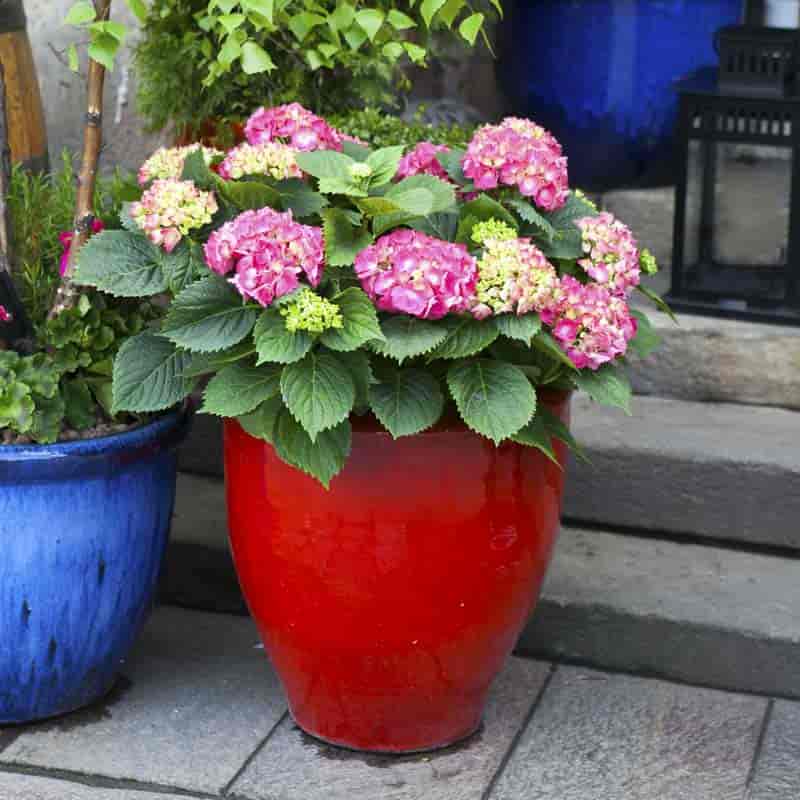

Understanding the Role of Soil Health
Soil is more than just a medium for plants to anchor their roots. It’s also their primary source of essential nutrients, water, and oxygen. Healthy, well-balanced soil should be:
- Rich in organic matter,
- Drain efficiently,
- Offer ample room for roots to breathe and grow.
Poor soil health can result from several factors, including over-watering, soil compaction, and nutrient depletion.
How to Improve Your Garden Soil’s Health
To enjoy blossoming hydrangeas, maintaining excellent soil health is critical. Here are key steps to enhance your garden soil’s vitality:
- Conduct Regular Soil Tests: Conduct soil tests every 2-3 years to comprehensively understand your soil’s pH level and any nutrient deficiencies. You can use do-it-yourself kits or send your soil sample to a lab for detailed analysis.
- Add Organic Matter Regularly: Supplement soil regularly with organic matter like compost, manure, or leaf mold to increase soil fertility and improve structure. This action enhances the soil’s capacity to hold water and allows better aeration.
- Nurture Proper Watering Practices: Avoid water-logging your soil. Over-watered soil becomes compact and suffocates plant roots, affecting their growth.
- Rotate Crops and Use Cover Crops: If you have a sizable garden, consider rotating crops and using cover crops. These practices help prevent nutrient depletion and soil-borne diseases.
Healthy soil is a critical factor in hydrangea care. A well-balanced, nutrient-rich, and well-drained soil base can lead to your garden’s lush, vibrant, blooming hydrangeas.
#9 – Disease On Hydrangeas
Diseases can greatly impact the performance and vitality of your hydrangeas, affecting their ability to bloom.
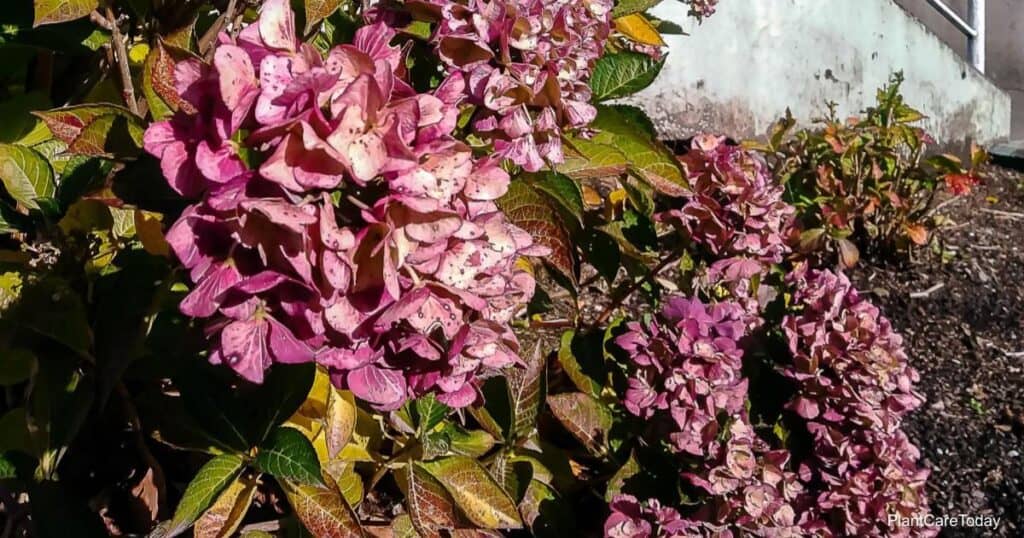

The effect of diseases on Hydrangea Blooming
Certain diseases can cause significant damage to hydrangeas, impeding their ability to flower. These include leaf spot diseases, like Cercospora and anthracnose, and root rot diseases, such as Phytophthora.
These diseases can weaken or ultimately kill the plants, halting their blooming. It’s important to monitor your hydrangeas for signs of disease, which include spots on the leaves, wilting, or an overall decline in vitality.
Disease Prevention and Treatment
Prevention is always better than cure, especially concerning diseases affecting your hydrangeas. Here are some measures you can take to prevent and treat diseases:
- Regular Inspections: Regularly inspect your hydrangeas for any signs of plant diseases. Early detection can go a long way in managing their impact.
- Appropriate Spacing: Ensure your hydrangeas have enough space for adequate air circulation. High humidity and poor air circulation favor the development of certain diseases.
- Pruning: Prune any diseased branches or leaves promptly to prevent the spread of diseases. Make sure to disinfect your pruning tools between cuts.
- Fungicides: Use fungicides as directed on the label to treat specific diseases. Always remember to follow recommended safety precautions when using any chemical treatments.
In conclusion, diseases can be an obstacle to successful hydrangea blooming. With consistent preventive measures and timely treatment, however, you can ensure your hydrangeas remain disease-free and maintain their bountiful bloom.
#10 – Pests
Even though hydrangeas are hardy by nature, they aren’t fully immune to the negative impacts of common garden pests. These uninvited guests can hinder the blooming process of hydrangeas, turning your potential flourish of blooms into a disappointment of bare green leaves.
Common Pests in Hydrangeas
There are a few notorious culprits known to plague hydrangeas:
- Aphids: Aphids are small, green, or black insects that can hamper the blooming process by sucking the sap out of the leaves and new growth.
- Japanese Beetles: These pests feed on hydrangea leaves and can cause substantial damage by skeletonizing the leaves (eating the leaf tissue between the veins), affecting overall plant health.
- Slugs and Snails: They usually feast on the tender new growth of hydrangeas, causing holes in the leaves, which can impede blooming.
Pest Prevention and Removal Methods
Ridding your hydrangeas of pests doesn’t necessitate turning your garden into a mini-pesticide factory. Here are some natural and environmentally friendly ways of dealing with common pests:
- Non-toxic Insecticidal Soaps: A soap and water solution sprayed directly onto pests can often kill them without causing harm to your hydrangeas or the environment.
- Beneficial Creatures: Inviting birds, frogs, and other creatures that feed on pests to your garden can naturally control their population.
- Organic Pesticides: If dealing with a large infestation, organic pesticides, such as neem oil, can be a safe and effective way to combat pests.
- Manual Removal: For small infestations, pests like beetles and snails can simply be picked off from the plants and disposed of.
In conclusion, keeping an eye out for common pests that could potentially impact the health and bloom of your hydrangeas is essential. With an active pest prevention and response method, you can ensure these beautiful plants continue to adorn your garden with magnificent blooms for years.
Our journey exploring why hydrangeas may not bloom has taken us through ten possible culprits. By now, you should have a better understanding of how crucial factors such as:
Review of the Key Reasons
- Pruning Timeframes: Hydrangeas may not bloom if pruned during the wrong season. It’s important to time your pruning right to encourage full blooms.
- Sunlight Needs: Both insufficient and excessive sunlight can negatively impact a hydrangea’s blooming process. The sweet spot is just enough sun with adequate shade.
- Soil pH: Hydrangeas are especially sensitive to soil pH levels, which can variably influence their blooming.
- Watering Requirements: Watering habits must be spot-on to foster hydrangea’s bloom. Not too little, not too much – just right!
- Nutrient Availability: An imbalance of certain nutrients in the soil can deter hydrangea’s blooming. It’s crucial to check and correct any imbalances regularly.
- Winter Rigor: Hydrangeas are hardy but not invincible. Harsh winters can damage them and obstruct their spring blooming.
- Soil Health: The overall health of your garden soil significantly influences the blooming potential of your hydrangeas.
- Disease and Pests: Lastly, like most garden staples, hydrangeas are subject to disease and pests, both of which can hamper blooming.
Final Thoughts and Encouragement
Remember that the beauty of maintaining a garden lies in the attention and love you pour into it – and yes, that includes handling non-blooming hydrangeas. We encourage you to observe your hydrangeas closely.
Don’t be afraid to investigate if you suspect things aren’t just right. Take this guide as your ally and make the necessary adjustments on your journey to a vibrant, blooming garden. After all, gardening combines art, science, and patience!
Keep your gardening gloves ready, your shears sharper, and your spirit undaunted. Here’s to you and your blooming hydrangeas!
